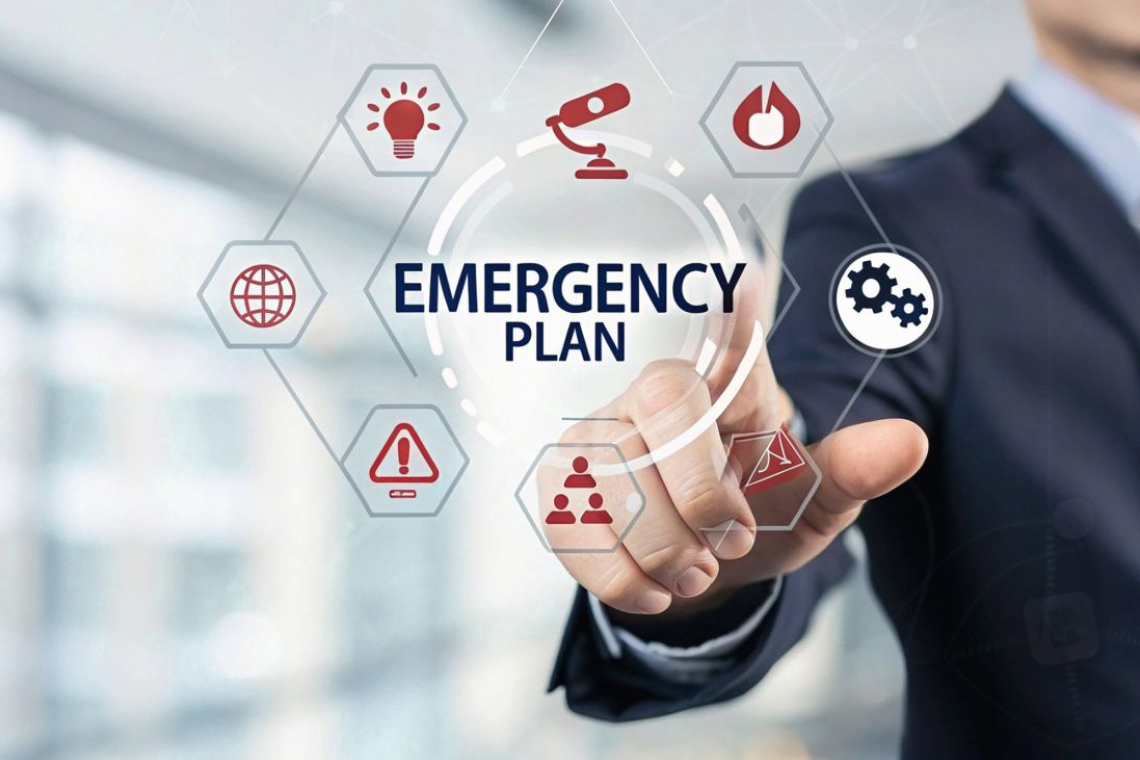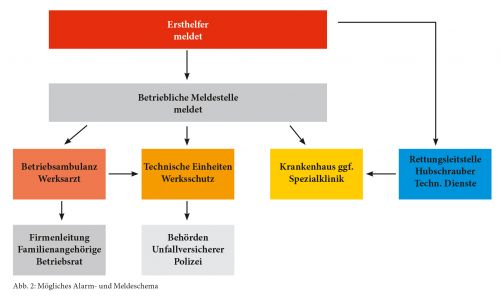- Part 1 - Basics and law
After sports, household and traffic accidents, accidents in the workplace only come in fourth place in the accident statistics. In this and the next two issues, you will find a general overview of legal principles, general information on accident management and finally a summary of the most important first aid measures.
As a general rule, not all accidents that happen at work are occupational accidents. Anyone who picks their nose while doing nothing at work and breaks their finger in the process is not covered by the accident statistics for companies. Nevertheless, the injured finger must be treated first. What was described here in a rather amusing way is quickly put into perspective when it comes to a heart attack.
In addition, many people wrongly assume that most accidents in a company happen in the machine-intensive environment of production or warehousing. After all, workers there have to deal with openly moving mechanical processes of conveyor belts, lifting devices or rotating rollers and, in the case of an electroplating plant, even with hazardous chemicals. Most accidents at work in German companies occur in administration or office workplaces. And in terms of frequency, it is falls and tripping incidents that make up the majority. Fortunately, the majority of these are minor injuries.
Staff: Help is mandatory
The concept of assistance
First of all, the law obliges everyone to provide assistance to another person if (emergency) situations require it. This is stipulated in Section 323 c of the German Criminal Code, which even makes failure to provide assistance a criminal offense: "Anyone who fails to provide assistance in the event of an accident or common danger or emergency, although this is necessary and reasonable under the circumstances, in particular without considerable risk to themselves and without violating other important obligations, shall be punished with imprisonment of up to one year or a fine."
First of all, the law obliges everyone to provide assistance to another person if (emergency) situations require it
"Help" is any means that is suitable for averting imminent harm. The question of the reasonableness of providing assistance must always be considered on a case-by-case basis. What assistance is reasonable depends, among other things, on the life experience and previous training of the person providing assistance. Persons with special expertise (e.g. licensed doctors) and special aids must do more than untrained lay helpers. It is not reasonable to provide assistance if you expose yourself or others to considerable danger or would have to violate other urgent duties.
What is first aid?
First aid is the provision of medical, organizational and supportive measures to sick or injured persons using simple means, including the emergency call.
First and foremost is the possible rescue of an accident victim: Anyone who is trapped must first be freed, anyone who is in a burning room must be pulled out, etc. Only then can the victim be treated.
To ensure that these initial measures are carried out as professionally as possible from the outset, companies of a certain size must appoint so-called first aiders who have been trained in first aid in accordance with the regulations of the statutory accident insurance institutions. Only those who are able to recognize which measures are necessary and know how to do them can help. In addition, help can only be provided if it is ensured that trained personnel are on site at all times and in all places in the event of an accident. In a company with two first aiders, it should therefore be ensured that both are never on vacation at the same time.
First aid that is limited to calling for medical help or rushing the injured to hospital could be fatal for emergency patients. To prevent irreparable damage or worse, help is needed until professional help arrives. Seamless assistance from the scene of the incident to the hospital can only be ensured through organizational measures.
Accordingly, first aid in the workplace is understood to mean services through which injured and sick persons are provisionally cared for by specially trained helpers to avert acute health and life-threatening situations. The field of first aid includes not only the measures to be carried out in a specific case, but also all organizational measures, precautions, equipment, material resources that prepare, enable and improve them or serve to record them. First aid is an important prerequisite for medical rehabilitation.
The following sequence of first aid measures has proven to be effective:
- Make an emergency call
- Secure the accident site
- Rescue the victim from the danger zone
- Examining the casualty
- Initial medical measures
The emergency call is of crucial importance. After all, it is the call that sets the often-invoked rescue chain in motion (Fig. 1) and brings professional help. The nationwide emergency number is 112 and the emergency call is made to the relevant rescue coordination center. It must clearly and concisely contain all the information required to bring the necessary rescue units to the scene of the emergency in a targeted manner and without wasting time. Further instructions and support are provided by the rescue coordination center.
If several rescuers are on site, one of them will immediately attend to the victim while another makes the emergency call. Attention should be paid to the composition of the rescuers: It is clear that the stronger man carries out rescue work and the weaker woman is responsible for the emergency call.
A professional emergency call follows the five W rule:
Where is the emergency?
Precise information about the emergency location: place, street, house number, factory building, access routes, floor, etc. is required.
Do not hang up afterwards!
Wait for questions from the rescue coordination center
In most cases, further information is important for the deployment of the rescue service and the fire department. For example:
What has happened?
The description of the course of the accident is decisive for the type and size of the rescue operation.
How many victims are there?
Provides the rescue coordination center with information, e.g. on the number of rescue vehicles.
Which injuries/illnesses
Composition of the specialist team, composition of resources, etc.
Technology: Means of communication
Every company must have suitable reporting and equipment to handle accidents professionally and quickly and as responsibly as possible for those affected. In the context of first aid, alarm and reporting devices serve to reliably notify and control the deployment of the necessary rescue units. This is also regulated and prescribed by law, for example in section 10, paragraph 1, sentence 3 of the Occupational Health and Safety Act, as well as in section 8, paragraph 2 and section 25, paragraph 1 of DGUV Regulation 1 "Principles of Prevention".
The most common reporting device is the telephone. However, it can only fulfill this function if the emergency number is visibly displayed. If the public emergency call center cannot be dialed directly, a permanently manned reporting point is required during working hours, for example, which records the internal emergency call and alerts the public rescue service if necessary. The company should also check whether the internal reporting system can be set up in such a way that the control center can see where the emergency call is being made.
In hazardous areas, it is advisable to install special emergency call points similar to fire alarms, which, when activated, trigger an alarm immediately, e.g. via the plant siren, and automatically display the location of the incident on monitors or illuminated panels in the control center, the company ambulance, the plant fire department and the gatekeeper, and indicate the nature of the incident.
Example:
The internal emergency call is made
- via telephone emergency number 777 in the event of serious accidents, especially life-threatening injuries
- via manual fire alarm, alternatively telephone emergency number 888 for fires, critical incidents and disasters
- via alarm button, alternatively via telephone emergency number 777 in the event of a gas hazard.
The manual fire alarms must be installed on the outside of the buildings; however, the alarm buttons are located directly at the workplaces.
Organization: Alarm and reporting plan
The alarm and reporting plan for first aid is the plan provided for the company for deploying the necessary rescue units to the right place as quickly as possible and for notifying the persons or bodies responsible for accompanying and subsequent measures. The legal basis can be found in the regulations of the DGUV "Principles of Prevention" and in the Occupational Health and Safety Act.
The alarm plan must enable people seeking help to make an emergency call to the responsible office via the alarm and reporting equipment installed in the company without losing any time, thereby enabling the necessary rescue units to be deployed. The responsibilities and tasks must be defined in the plan in such a way that all those responsible can fulfill their duties without delay on the basis of the message received. The plan must take into account every type of accident that may occur in the company (e.g. casualties as a result of fire, gas leakage or collapse, single casualties, several or many casualties) and address the internal and external emergency services required. The plan must be made available to all departments listed in the plan. Employees must be informed of the alarm plan. A mere notice is not sufficient. The plan must be explained to provide complete information. It must be updated, i.e. adapted to changed operational conditions if necessary.
The alarm and reporting scheme presented here (Fig. 2) is an example of the facilities and locations that can be included in an alarm and reporting plan for first aid and how the alarm and reporting routes could be organized. The design of the plan depends on the operational conditions such as size, structure, organization and available resources.




